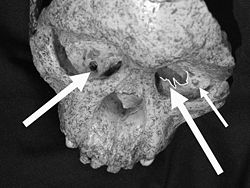Australopithecus africanus
Austalopithecus africanus was first discovered by Raymond Dart in 1925. He found a well-preserved skull of a young australopithecine, three to four years old. This skull is often called the Taung Child, after Taung, South Africa where it was found. It is perhaps the most complete skull of A. africanus known.[1] Based on current data A. africanus dates to between 3.03 and 2.04 million years ago.[2]
| Australopithecus africanus Temporal range: Pliocene
| |
|---|---|

| |
| Natural endocranial cast (485 cm3) (Sts 60), articulated with a fragmentary skull still embedded in breccia (TM 1511) | |
| Scientific classification | |
| Kingdom: | |
| Phylum: | |
| Class: | |
| Order: | |
| Family: | |
| Genus: | |
| Binomial name | |
| †Australopithecus africanus Dart, 1925
| |
Australopithecus africanus had a dish shaped facial structure with teeth that were large compared to modern humans. While it had larger front teeth compared to the back, the emphasis was on back tooth grinding. Males had a sagital crest on the tops of their skulls. Large muscles were attached to this ridge that helped to support the heavy jaw.[3]
Australopithecus Africanus Media
Cast of Taung child from the collection of the University of the Witwatersrand
Mrs. Ples at the Ditsong National Museum of Natural History, Pretoria
Reconstructed skull of Mrs. Ples at the Beijing Museum of Natural History
Australopithecus africanus pelvis and vertebrae at the American Museum of Natural History
Taung child skull noting raptor-inflicted damage to the eye sockets
Related pages
References
- ↑ Leakey, Richard 1994. The origin of humankind. New York: BasicBooks. ISBN 0465031358
- ↑ Herries A.I.R. et al 2010. Geochronology and palaeoenvironments of the South African early hominin bearing sites: a reply to ‘Wrangham et al., 2009: Shallow-water habitats as sources of fallback foods for hominins’ Am. J. Phys. Anthro. 143, 640–646
- ↑ Wood B.A. 1994. Evolution of australopithecines. In Jones S. Martin R. & Pilbeam D. (eds) 2004. The Cambridge encyclopedia of human evolution. 8th ed, Cambridge University Press. ISBN 0-521-46786-1






